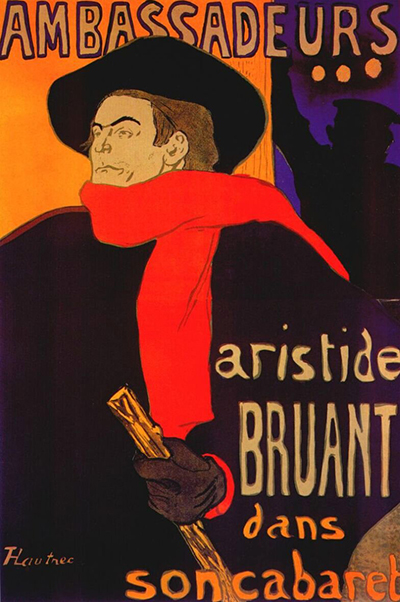Ambassadeurs, Aristide Bruant is a lithograph poster, which was originally created in 1892 by the French artist Henri de Toulouse-Lautrec.
The main subject of the poster is the cabaret singer, Aristide Bruant, who is featured prominently, and the artwork was produced to advertise one of his upcoming performances, at the Ambassadeurs club in Paris. The poster was commissioned by Aristide Bruant personally, on behalf of the Ambassadeurs club, and would go on to become one of Henri de Toulouse-Lautrec's best-known works. Evident within the poster is the inspiration the artist took from the Impressionists of the 19th century, as well as the ukiyo-e artists from Japan.
At the time of the poster's creation in 1892, Henri de Toulouse-Lautrec had already risen to some degree of fame within Paris. In particular, he was known for his 1891 poster, Moulin Rouge: La Goulue. That work was Toulouse-Lautrec's first foray into the world of lithographic posters, and was an instant success, with around 3,000 copies being produced. Nevertheless, Aristide Bruant had actually become familiar with Henri de Toulouse-Lautrec's work several years prior to the creation of his first lithograph poster. The two became friends and he personally approached Toulouse-Lautrec with a request to create a poster for his new show, which he was set to debut at Paris' Ambassadeurs club.
Upon seeing the poster, the club's owners were reportedly horrified. In fact, it is said that Pierre Ducarrem, the manager of the Ambassadeurs club, refused to pay for it and described it as a "revolting mess". This led to a stand-off between him and Aristide Bruant, who believed it to be a masterpiece. Bruant eventually issued an ultimatum, refusing to perform unless the poster was put up around Paris and featured on the stage. Ducarrem eventually backed down, the poster was put up around Paris, and it was also used to decorate the proscenium arch. It proved to be popular within the city, enhancing the status of both Toulouse-Lautrec and Bruant.
The poster itself consists of an Art Nouveau-style image of Aristide Bruant, who is dressed in a black hat, black cape and red scarf. It is a colour poster and, like many of Toulouse-Lautrec's posters from around this time, it showcases his preference for lithographic ink rather than crayon. However, crayon became much more heavily featured in his posters from around 1893 onward, with Divan Japonais (1893) being an obvious example. One of the defining features of the poster is its simplicity. Indeed, it has very few elements: a portrait of the subject, a headline, a small amount of additional text, a simplified background and a second figure in silhouette in that background. In this sense, it is very similar to the aforementioned Moulin Rouge: La Goulue poster.
Another common feature of Toulouse-Lautrec's works is the positioning of the main subject, off-centre, to the left of the page. This helps to create a sense of space around them, but still allows the main subject to occupy the vast majority of the poster. This same technique is used on several of his other works, like Avril (1883) and May Belfort (1895). The lithograph itself measures 1,513 mm x 983 mm and features the text: 'Ambassadeurs... Aristide Bruant dans son cabaret' - which translates to 'Ambassadeurs... Aristide Bruant and his cabaret'. It was originally printed in two parts, which were woven together across the middle, resulting in slightly different colours on the top and bottom halves.
As previously stated, Henri de Toulouse-Lautrec took much of his inspiration from the Impressionist-era artists of the 19th century, with specific examples including Edgar Degas and Édouard Manet. Although perfectly capable of capturing fine detail, Toulouse-Lautrec's lithograph posters tended to feature simplified faces and dramatic colours. His Ambassadeurs, Aristide Bruant poster is certainly in-keeping with this preference. The poster is also heavily inspired by the Japanese ukiyo-e genre. It is known that Henri de Toulouse-Lautrec had a great appreciation for these Japanese colour wood prints, which became especially popular in Paris and the surrounding area during his lifetime. Ambassadeurs, Aristide Bruant resembles these wood prints in a number of ways, including the use of abstractions, exaggerated vulgarity, bold colours and simplified facial features.
With works like Ambassadeurs, Aristide Bruant and Moulin Rouge: La Goulue, Henri de Toulouse-Lautrec is sometimes credited with re-defining the art of lithograph posters. Additionally, his work is often seen as a crucial predecessor to the post-World War II American pop art movement, which was spearheaded by artists like Andy Warhol.




